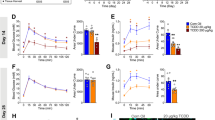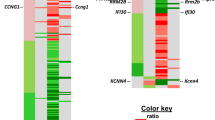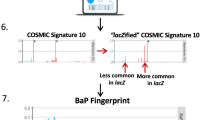Abstract
Transgenic mice for genotoxicity testing have been developed, although no such models have been produced for the evaluation of toxic, nongenotoxic chemical compounds. We have developed a transgenic mouse model for the analysis of toxic inorganic compounds. We engineered a mouse lineage with the human growth hormone (hGH) gene under the control of the human hsp70 promoter, in which a plasma-detectable hGH response can be elicited by exposure to heat shock. In primary cell cultures from these mice, hGH release was observed following treatment with several toxic inorganics. Transgenic mice injected intraperitoneally with sodium arsenite, cadmium chloride, copper sulphate, or methylmer-curium chloride showed significant hGH levels in plasma.
This is a preview of subscription content, access via your institution
Access options
Subscribe to this journal
Receive 12 print issues and online access
$209.00 per year
only $17.42 per issue
Buy this article
- Purchase on Springer Link
- Instant access to full article PDF
Prices may be subject to local taxes which are calculated during checkout
Similar content being viewed by others
References
Jaenisch, R. 1988. Transgenic animals. Science 240: 1468–1474.
Merlino, G.T. 1991. Transgenic animals in biomedical research. FASEB J 5: 2996–3001.
Bradley, A., Hasty, P., Davis, A. and Ramirez-Soli, R. 1992. Modifying the mouse: design and desire. Biotechnology 10: 534–539.
Gossen, J.A., De Leeuw, W.J.F., Tan, C.H.T., Zwarthoff, E.C., Berends, R., Knook, D.L. et al. 1989. Efficient rescue of integrated shuttle vectors from transgenic mice: a model for studying mutations in vivo. Proc. Natl. Acad. Sci. USA 86: 7971–7975.
Kohler, S.W., Provost, G.S., Reck, A., Kretz, P.L., Bullock, W.O., Sorge, J.A. et al. 1991. Spectra of spontaneous and mutagen-induced mutations in the Lad gene in transgenic mice. Proc. Natl. Acad. Sci. USA 88: 7958–7862.
Douglas, G.R., Jiao, J., Gingerich, J.D., Gossen, J.A. and Soper, L.M. 1995. Temporal and molecular characteristics of mutations induced by ethylnitrosourea in germ cells isolated from seminiferous tubules and in spermatozoa of lacZ transgenic mice. Proc. Natl. Acad. Sci. USA 92: 7485–7489.
Boerrigter, M.E.T.I., Dollè, M.E.T., Martus, H.J., Gossen, J.A. and Viij, J. 1995. Plasmid-based transgenic mouse model for studying in vivo mutations. Nature 377: 657–659.
Gossen, J.A. and Vijg, J. 1993. Transgenic mice as model systems for studying gene mutations in vivo. Trends Genet. 9: 27–31.
Albertini, R.J. 1994. Why use somatic mutations for human biomonitoring? Env. Mol. Mutagen. 23(Suppl 24): 18–22.
Goldsworthy, T.L., Recio, L., Brown, K., Donehower, L.A., Mirsalis, J.C., Tennant, R.W. et al. 1994. Transgenic animals in toxicology. Fundam. Appl. Toxicol. 22: 8–19.
Nover, L. 1987. Expression of heat shock genes in homologous and heterologous systems. Enzyme Microb. Technol. 9: 129–144.
Hightower, L.E. and Ryan, J.A. 1997. Are stress proteins part of a cell's solution to toxicity or are they part of the problem? Hepatology 25: 1279–1281.
Huggett, R.J., Kimerle, R.A., Mehrle, P.M., and Bergman, H.L. 1992. Biomarkers: biochemical, physiological and histological markers of anthropogenic stress. Lewis Publishers, Boca Raton, FL.
Dreano, M., Brochot, J., Myers, A., Cheng-Myers, A., Rungger, D., Voellmy, R. et al. 1986. High-level, heat-regulated synthesis of proteins in eukaryotic cells. Gene 49: 1–8.
Dreano, M., Fischbach, M., Montandon, F., Salina, C., Padieu, P. and Bromley, P. 1988. Production of secretable proteins using the passage in vivo as tumors of cells carrying heat-inducible expression constructs. Biotechnology 6: 953–958.
Fischbach, M., Sabbioni, E. and Bromley, P. 1993. Induction of the human growth hormone gene placed under human hsp70 promoter control in mouse cells: a quantitative indicator of metal toxicity. Cell Biol. Toxicol. 9: 177–188.
Levinson, W., Opperman, H. and Jackson, J. 1980. Transition series metals and sulfhydril reagents induce the synthesis of four proteins in eukaryotic cells. Biochem. Biophys. Ada. 606: 170–180.
Honda, K., Hatayama, T., Takahashi, K. and Yukioka, M. 1992. Heat shock proteins in human and mouse embryonic cells after exposure to heat shock or teratogenic agents. Teratog. Carcinog. Mutagen. 11: 235–244.
Goehring, P.L., Fisher, B.R., Chaudary, P.P. and Dick, C.A. 1992. Relationship between stress protein induction in rat kidney by mercuric chloride and nephro-toxicity. Toxicol. Appl. Pharmacol. 113: 184–191.
Goehring, P.L., Fisher, B.R. and Kish, C.L. 1993. Stress protein synthesis induced in rat liver by cadmium precedes hapatotoxicity. Toxicol. Appl. Pharmacol. 122: 139–148.
Ovelgonne, H.H., Wiegant, F.A.C., Souren, J.E.M., van Rijn, H., and van Wijk, R. 1995. Enhancement of the stress response by low concentrations or arsenite in arsenite-pretreated Reuber H35 hepatoma cells. Toxicol. Appl. Pharmacol. 132: 146–155.
Ovelgonne, H.H., Souren, J.E.M., Wiegant, F.A.C. and van Wijk, R. 1995. Relationship between cadmium-induced expression of heatshock genes, inhibition of protein synthesis and cell death. Toxicology 99: 19–30.
Salminen, W.F., Voellmy, R. and Roberts, S.M. 1996. Induction of hsp in HepG2 cells in response to hepatotoxicants. Toxicol. Appl. Pharmacol. 141: 117–123.
Richardson, M.L. L. (ed.). 1993. The dictionary of substances and their effects. The Royal Society of Chemistry, Cambridge, see compounds listed in alphabetical order).
Aresini, G., Karcher, W., Roi, R. and Sevilla-Marcos, J.M. 1995. Data profiles for selected chemical series. Report EUR 16248 EN.
Plunket, E.R. 1987. Handbook of industrial toxicology. Chemical Publishing Co. Inc., New York.
Roush, W. 1996. Hunting for animal alternatives. Science 274: 168–171.
Dreano, M., Marq, J.B. and Bromley, B.R. 1988. Antibody formation against heat-induced gene products expressed in animals. Biotechnology 6: 1340–1343.
Festing, M.F.W. 1997. Fat rats and carcinogenesis screening. Nature 388: 321–322.
Hogan, B., Costantini, F. and Lacy, E. 1986. Manipulating the mouse embryo: a laboratory manual.Cold Spring Harbor Laboratory Press, Cold Spring Harbor, NY.
Sambrook, J., Fritsch, E.R. and Maniatis, T. 1989. Molecular cloning: a laboratory manual.Cold Spring Harbor Laboratory Press, Cold Spring Harbor, N.Y.
Innis, M.A., Gelfand, D.H., Sninsky, J.J. and White, T.J. 1990. PCR protocols: a guide to methods and applications. Academic Press, New York.
Robertson, E.J., 1987. pp.77–88 in Teratocarcinomas and embryonic stem cells: a practical approach.IRL Press, Oxford, UK.
Clerici, L., Sacco, M.G. and Merlini, M. 1989. Acetaldehyde activation of poly(ADP-ribose) polymerase in hepatocytes of mice treated in vivo. Mut Res. 227: 47–51.
Campbell, J.A., Eppersimons, C.R., Kligerman, A.D., Petro, A.R., Sharief, Y. and Allen, J.W. 1986. Sister cromatid exchange analysis in cultured primary lung, liver and kidney cells of mice following in vitro exposure to vinyl carbamate. In Vitro Cell Dev. Biol. 22: 443–448.
Dexter, T.M., Allen, T.D. and Lajta, L.G. 1977. Conditions controlling the proliferation of hemopoietic stem cells in vitro. J. Cell Physiol. 91: 335–339.
Author information
Authors and Affiliations
Rights and permissions
About this article
Cite this article
Sacco, M., Zecca, L., Bagnasco, L. et al. A transgenic mouse model for the detection of cellular stress induced by toxic inorganic compounds. Nat Biotechnol 15, 1392–1397 (1997). https://doi.org/10.1038/nbt1297-1392
Received:
Accepted:
Issue Date:
DOI: https://doi.org/10.1038/nbt1297-1392
This article is cited by
-
Development of a bicistronic vector for multimodality imaging of estrogen receptor activity in a breast cancer model: preliminary application
European Journal of Nuclear Medicine and Molecular Imaging (2008)
-
A sensitive transgenic plant system to detect toxic inorganic compounds in the environment
Nature Biotechnology (2001)
-
Shock toxicology with transgenics
Nature Biotechnology (1997)



